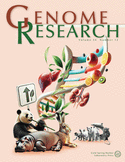A model of segmental duplication formation in Drosophila melanogaster
Abstract
Segmental duplications (SDs) are low-copy repeats of DNA segments that have long been recognized to be involved in genome organization and evolution. But, to date, the mechanism of their formation remains obscure. We propose a model for SD formation that we name “duplication-dependent strand annealing” (DDSA). This model is a variant of the synthesis-dependent strand annealing (SDSA) model—a double-strand break (DSB) homologous repair model. DSB repair in Drosophila melanogaster genome usually occurs primarily through homologous repair, more preferentially through the SDSA model. The DDSA model predicts that after a DSB, the search for an ectopic homologous region—here a repeat—initiates the repair. As expected by the model, the analysis of SDs detected by a computational analysis of the D. melanogaster genome indicates a high enrichment in transposable elements at SD ends. It shows moreover a preferential location of SDs in heterochromatic regions. The model has the advantage of also predicting specific traces left during synthesis. The observed traces support the DDSA model as one model of formation of SDs in D. melanogaster genome. The analysis of these DDSA signatures suggests moreover a sequestration of the dissociated strand in the repair complex.
Footnotes
-
↵3 Corresponding author.
↵3 E-mail fiston{at}ijm.jussieu.fr; fax 33-1-4427-3660.
-
[Supplemental material is available online at www.genome.org.]
-
Article published online before print. Article and publication date are at http://www.genome.org/cgi/doi/10.1101/gr.6208307
-
- Received December 13, 2006.
- Accepted June 27, 2007.
-
Freely available online through the Genome Research Open Access option.
- Copyright © 2007, Cold Spring Harbor Laboratory Press











